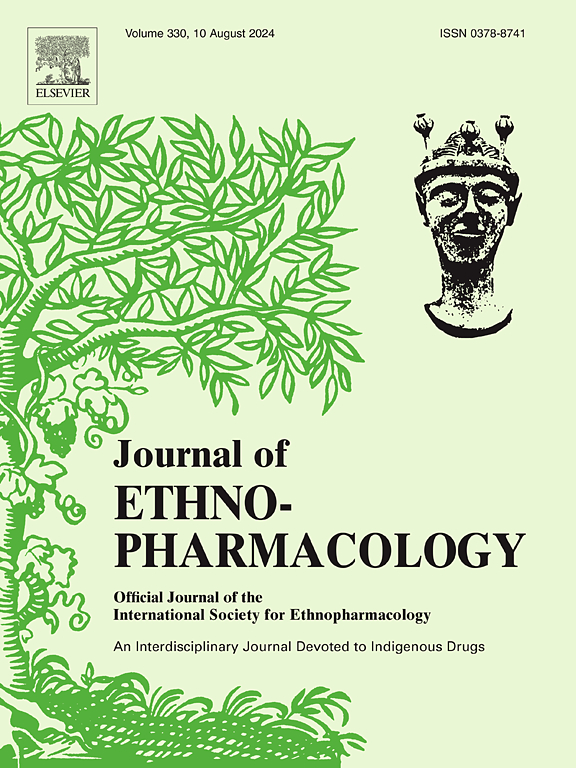Longan Arillus: A comprehensive review of botany, traditional uses, phytochemistry, pharmacologic activities, pharmacokinetics, quality control, toxicity, and clinical applications
IF 4.8
2区 医学
Q1 CHEMISTRY, MEDICINAL
引用次数: 0
Abstract
Ethnopharmacological relevance
Longan Arillus (LA) is the aril of Dimocarpus longan Lour. of the Sapindaceae family, commonly known as Guiyuan, whose first documentation can be traced back to the ancient book “Shen Nong's herbal classic”. Since ancient times, LA has been commonly used in combination with other herbs or ingredients to make a variety of formulas and medicinal products, which were used to treat diseases such as insomnia, forgetfulness, neurasthenia, overthinking, fatigue, and deficiency of qi and blood, e.g., “Gui Spleen Tang”, “Yu Ling Cream”, “An Shen Ding Zhi Pill”, etc.
Aim of the review
This paper presents a comprehensive review encompassing LA's traditional usage, quality control, botany, phytochemical constituents, pharmacological activities, toxicological profiles, pharmacokinetic properties, and clinical applications. The aim is to provide an extensive overview of the current research landscape, facilitating further exploration and utilization of LA resources.
Materials and methods
This article uses “Dimocarpus longan Lour.” and “Longan Arillus” as the keywords and collects relevant information on LA from different databases, including PubMed, Web of Science, X-mol, Sci-finder, SCI-HUB, CNKI, Chinese Masters and Doctoral Dissertations, Wanfang Data, Baidu Scholar, Google Scholar, ancient material medica and the Pharmacopoeia of the People's Republic of China (2020).
Results
To date, a total of 378 compounds have been identified in LA, including 12 sugars, 28 polyphenols, 234 volatile components, 12 terpenes and steroids, 28 organic acids, 15 lipids, 11 nucleosides, 32 amino acids and 6 others compounds. Among them, polysaccharides and polyphenols are its main active ingredients. LA has a variety of biological activities, such as immunoregulatory activity, inhibition of Alzheimer's disease, anti-inflammatory, anti-tumor, antioxidant, and inhibition of osteoporosis. In particular, immunomodulatory effects have received much attention. Pharmacological studies have shown that LA enhances immunomodulatory activity through signaling pathways such as MAPK, PI3K/Akt, NF-κB, and MyD88/TRAF6. In addition, this paper reveals the shortcomings of current LA research and its possible future research directions.
Conclusions
This paper provides a comprehensive review of LA and highlights its multiple pharmacological activities, particularly immunomodulatory effects. However, the current in vivo and clinical studies of LA are relatively limited. Consequently, the scope of in vivo and clinical studies should be expanded in the future. In addition, it is highly recommended that further research efforts be directed towards pharmacokinetics and quality control of LA, and a reference for future studies on clinical application and new product development of LA.

龙眼香:植物学,传统用途,植物化学,药理活性,药代动力学,质量控制,毒性和临床应用的综合综述。
民族药理学相关性:龙眼Arillus (LA)是龙眼树的假种皮。其最早的文献记载可追溯到古书《神农本草经》。自古以来,LA常与其他草药或配料配用,制成各种配方和药品,用于治疗失眠、健忘、神经衰弱、思维过度、疲劳、气血不足等疾病,如“归脾汤”、“郁陵膏”、“安神定止丸”等。综述的目的:本文介绍了全面的综述,包括LA的传统用法,质量控制,植物学,植物化学成分,药理活性,毒理学特征,药代动力学性质和临床应用。目的是提供当前研究概况的广泛概述,促进LA资源的进一步探索和利用。材料与方法:本文以“Dimocarpus龙眼Lour.”和“龙眼Arillus”为关键词,从PubMed、Web of Science、X-mol、Sci-finder、SCI-HUB、CNKI、中国硕士和博士论文、万方数据、百度Scholar、谷歌Scholar、古籍药物和中华人民共和国药典(2020)等数据库中收集龙眼的相关信息。结果:迄今为止,在LA中共鉴定出378种化合物,包括12种糖、28种多酚、234种挥发性成分、12种萜烯和类固醇、28种有机酸、15种脂类、11种核苷、32种氨基酸和6种其他化合物。其中,多糖和多酚是其主要活性成分。LA具有多种生物活性,如免疫调节活性、抑制阿尔茨海默病、抗炎、抗肿瘤、抗氧化、抑制骨质疏松等。特别是免疫调节作用已受到广泛关注。药理研究表明,LA通过MAPK、PI3K/Akt、NF-κB、MyD88/TRAF6等信号通路增强免疫调节活性。此外,本文还揭示了当前LA研究的不足之处以及未来可能的研究方向。结论:本文对LA进行了全面的综述,并强调了其多种药理活性,特别是免疫调节作用。然而,目前LA的体内和临床研究相对有限。因此,体内和临床研究的范围应该在未来扩大。建议进一步开展LA的药代动力学和质量控制方面的研究,为LA的临床应用和新产品开发提供参考。
本文章由计算机程序翻译,如有差异,请以英文原文为准。
求助全文
约1分钟内获得全文
求助全文
来源期刊

Journal of ethnopharmacology
医学-全科医学与补充医学
CiteScore
10.30
自引率
5.60%
发文量
967
审稿时长
77 days
期刊介绍:
The Journal of Ethnopharmacology is dedicated to the exchange of information and understandings about people''s use of plants, fungi, animals, microorganisms and minerals and their biological and pharmacological effects based on the principles established through international conventions. Early people confronted with illness and disease, discovered a wealth of useful therapeutic agents in the plant and animal kingdoms. The empirical knowledge of these medicinal substances and their toxic potential was passed on by oral tradition and sometimes recorded in herbals and other texts on materia medica. Many valuable drugs of today (e.g., atropine, ephedrine, tubocurarine, digoxin, reserpine) came into use through the study of indigenous remedies. Chemists continue to use plant-derived drugs (e.g., morphine, taxol, physostigmine, quinidine, emetine) as prototypes in their attempts to develop more effective and less toxic medicinals.
 求助内容:
求助内容: 应助结果提醒方式:
应助结果提醒方式:


